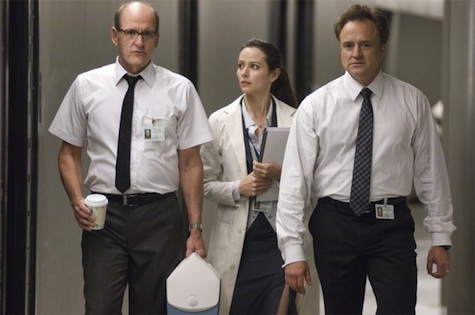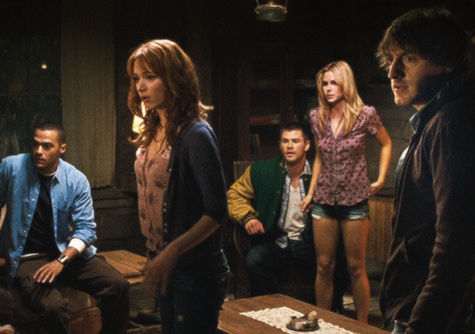When I saw Joss Whedon and Drew Goddard’s The Cabin in the Woods a week ago, I honestly wasn’t sure what to expect—I knew there was some sort of twist involved, and that the movie was intended to be a critique of ultraviolent slasher films, but I’d somehow avoided any major spoilers, going in. So, I spent at least half the movie desperately trying to guess how all the narrative pieces were going to fall into place, attempting to stay one step ahead of all the clever twists (and mostly failing)…and of course there’s a fair amount of pleasure to be had from all that frantic not-knowing.
The biggest surprise, though, occurred after I’d left the theater and started mulling the whole experience over, and realized that while I’d expected something smart, snarky, and fun, what The Cabin in the Woods delivers is much, much darker and more subversive than simply cleverness for its own sake. I never would have guessed how much time I’d spend thinking about just how well the film manages to illuminate the deeply weird cultural moment we currently find ourselves in, and how it all comes back to John Hughes… and how maybe all we really need to know we learned from Eighties movies. Or not.
Contains spoilers for Cabin in the Woods, The Hunger Games, and also probably The Breakfast Club, if you haven’t seen it…
I don’t tend to group Joss Whedon in with the cadre of Generation X directors that popped up in the 90s, maybe because he was making some of the best TV ever while people like Kevin Smith, Richard Linklater, and Quentin Tarantino were the becoming the new hotshots of indie film. Clearly, though, as much as these slippery generational labels count for anything, Whedon is a Gen X director: born in 1964, he grew up with the classic slasher film*, from the lower budget Black Christmas and Texas Chainsaw Massacre in 1974 to Halloween (1978) and Friday the Thirteenth (1980). By 1983, some sources estimate that the genre was responsible for nearly 60% of the domestic box office**, spinning off into sequels and prequels that continue to stagger on to screens over two decades later.
*Yes, I know about Psycho (1960). We could get even more academic about it, but for the purposes of this article I’m going to stick with 1974 as slasher ground zero.
**Crystal Lake Memories: The Complete History of Friday the 13th(2005)
We’re all familiar with the basic formula of these early films, featuring a carefree, freedom-loving youth culture in conflict with stunted, backward gargoyles grimly rooted in the past (usually thanks to some earlier trauma) and fueled by a pathological hatred for fun, sex, and rock and roll. The genre’s alpha-boogiemen quickly gained their own cult, antihero status—Leatherface, Freddy Krueger, Jason Voorhees, and Michael Myers were the stars of their own franchises: terrifying, unstoppable, but also a known quantity, bound by the strict conventions of the genre itself. They were the familiar (albeit horribly burned/scarred/masked) faces of a tightly controlled synthetic nightmare.
After years of raking in the bloodstained bucks off the corpses of fictional dead teenagers, the sun finally seemed to be setting on the slasher genre until the mid-90s rolled around to revivify its hulking corpse. Around the same time Whedon and Company started nudging Buffy Summers and her loyal Scoobies through the various horrors of high school, movies like Scream, I Know What You Did Last Summer, and Final Destination parodied the conventions of “classic” slasher films with a fresh crop of smart, savvy teen protagonists and plenty of self-referential humor. As with Buffy, these protagonists tended to be more empowered than the helpless victims of yore, and while there was still plenty of grist for the murder mill in these later films, the trend seemed to be heading toward clever wisecracks and pop culture references and away from the backwoods Grand Guignol bloodbath.
Except not. We entered a new millennium, and apparently Hollywood lost its mind: witness Saw (2004), Hostel (2005), the remakes of The Last House on the Left (2009) and I Spit on Your Grave (2010), and The Human Centipede (2010). It sounds ridiculous to say that that this was the decade when horror movies got dark, but …have you seen these movies? Are we that burned out, as a culture, that it takes some dank combination of sexual torture, self-mutilation, and maybe a flesh-eating clown reenacting medieval surgery techniques to even get worked up any more?
Culturally speaking, if slasher films (and the genre’s more recent outgrowth, torture porn) are supposed to reflect the social and political tensions and anxieties of our society, what does the last decade this say about us? It’s relatively easy to look back at what was going on in the mid-seventies and start serving up analysis and theories about why this genre caught on like wildfire, with its liberated, upwardly mobile post-flower children and proto-yuppies being punished for their privilege, dragged screaming from the sunlight of the suburban American dream and sacrificed for some perceived sin…but I feel like we’ve lost sight of the enemy in recent years.
It’s not about Freddy or Jason anymore. The familiar boogiemen have been replaced by more random, faceless evils and mindless, relentless gore. I’d argue that the genius of The Cabin in the Woods lies precisely in the fact that it leads its audience to question what the genre has become, and what we’re getting out of it. If horror movies are a safe way of exploring fears both primal and cultural, what do we really need to be afraid of, now, in 2012? It’s not the escaped maniac with a hook haunting lovers’ lanes, and it’s not Leatherface (or Deadites, or an off-brand Pinhead, or even a rampaging killer unicorn) …turns out, the new face of ultimate evil is two pasty, middle-aged guys in a golf cart. Or at least, it’s what they represent.

Slapping the ominous, blood-red opening titles over the scene of the delightful Bradley Whitford and Richard Jenkins bantering about power tools and childproof locks was certainly a fun way to kick off the film, but in retrospect, it’s also incredibly fitting. Beyond the humorous discord between their banal chatter and the sudden, jarring, horror-style freeze frame, the movie’s also telling us (or at least the protagonists, our temporary stand-ins), “You should be terrified of these people. They are the ones who make the decisions that affect you and the people you love. These guys control your world, and they are out to get you.”
It’s often remarked that Buffy was a teen comedy/drama with horror elements added in, brilliantly literalizing the metaphor of the utter hellishness of high school; Cabin in the Woods, on the other hand, is horror hiding a militant pro-youth agenda. It’s not interested in the dubious catharsis of seeing one or two hopelessly traumatized survivors stumble out of the woods come daybreak—it wants to know why these college kids (young adults, really) need to be punished, and why we, the audience, are watching in the first place.
It’s remarkable how powerful and self-evident the critique becomes over the course of the movie, but without ever detracting from our investment in the narrative…if anything, the more the underlying critique surfaced, the more invested I became. Part of that is the sheer cleverness and novelty of the plot and the way it’s structured, but it’s also down to the humor and offbeat earnestness of the characters themselves. Both are hallmarks of Whedon’s style, but watching the final scene, it finally hit me that with The Cabin in the Woods Whedon’s actually constructed a horror film around the heart (and the politics) of a John Hughes movie. On steroids.
In movies like The Breakfast Club and Pretty in Pink, the story revolves around teenagers laboring under the expectations and prejudices of parents and other adults, all the usual social pressures and constructed, preconceived notions that are needlessly divisive, alienating the rich kids from the poor kids, the brains from the jocks, Ally Sheedy from …everyone. And inevitably, the lesson Hughes’ protagonists learn is not to let other people define you, or punish you for being yourself, and most importantly: not to give in to fear and conformity.
It’s no secret that Whedon is a John Hughes fan, and comparisons are often made between their work, so maybe it’s no surprise that the final scene of The Cabin in the Woods borrowed that archetypal John Hughes lesson, upped the stakes, and transformed it into a life-or-death proposal. The fate of the world suddenly depends on this kind of decision: sacrifice yourself or your friend to save the culture that would control you, pigeonhole you, and utterly dismiss you as an individual—a culture made possible by fear and enforced convention. Play your assigned part in perpetuating that cycle …or, tell that world to go to straight to hell. Literally.
Sitting in the theater, watching as the survivors finally realize that they’ve been manipulated and forced into certain roles from the beginning (The Virgin, The Fool, The Whore, etc), all I could think was that the movie had turned into The Breakfast Club: Apocalypse Edition. It sounds like a joke at first, and Kristen Connolly’s distinctly Ringwaldian charms may have made the connection a little easier, but for me, the final rejection of their roles resonates with the exact same spirit that makes The Breakfast Club so beloved by Gen X-ers and subsequent generations of viewers (but with a seething Lovecraftian abyss substituted for the high school library setting. Natch.)
As fun and funny as this movie can be in parts, the more I think about the ending in those terms, the more I appreciate how radical and subversive it really is. The last movie I saw before Cabin was The Hunger Games, which almost ends in a suicide pact between the two main characters, unwilling to be manipulated and controlled any longer. Sound familiar? I don’t have room here to delve into all the similarities between the two films, but they have a lot more in common than you’d think, at first glance: youth sacrifice, surveillance/voyeurism, evil-as-routine-bureaucracy, and, eventually, rebellion in the face of institutionalized murder.
Obviously, there’s no way to look at two hit movies that happen to be out at the same time and declare a trend in the making, but I find it interesting that the both films exemplify such a glaring distrust of authority and traditional roles and behaviors. There’s plenty for young people to be anxious about in today’s current political and economic atmosphere…perhaps it makes sense to look past the obvious boogiemen and focus on systems of control instead. In a world so overwhelmed with white noise, discord, and disinformation, maybe it’s the fear of being manipulated that needs to be faced head-on, not embraced. Joss Whedon clearly knows the difference; torture porn does not. Your move, Hollywood.
Bridget McGovern is the non-fiction editor of Tor.com. She is going camping in the woods next weekend, because life has a hilarious sense of timing. If she survives, you can follow her on Twitter.










